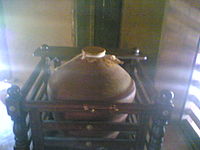- Nambiar (Ambalavasi/Mizhavu)
-
 Guru Padma Shri Mani Madhava Chakyar performing Chakyar koothu
Guru Padma Shri Mani Madhava Chakyar performing Chakyar koothu
Nambiar and Chakyar in the context of temple art forms like Chakyar koothu, Koodiyattam, Ottanthullal and similar cultural things refers to the Hindu community in the state of Kerala, India, belonging to the Ambalavasi community. Members of this Ambalavasi community undergo Upanayanam (sacred thread ceremony). Nambiars followed the Marumakkathayam (Matrilineal) system of inheritance.
The Sanskrit name of Nambiar is Pānivāda. 'pāni' means hands and 'vāda' comes from the verb 'vādanam' meaning playing; altogether meaning the one who plays with hands, since Nambiars are assigned to play the holy drum "Mizhavu" , which they play with their hands only. Nambiars are assigned to play the drum "Mizhavu" in ritualistic temple performances like Koodiyattam and koothu in Koothambalams inside the temples. These highly refined art forms narrating stories from Hindu epics and puranas, combined with prevailing socio-political events, were originally performed in temples in connection with festivals by members of this community along with Chakyar community. The nambiars who play Mizhavu are sometimes called as Chakyar Nambiars or Mizhavu Nambiars. Their ladies are called Nangyarammas. While Nambiars were allowed to play Mizhavu, Nangyarammas performs lady characters in Koodiyattam along with Chakyar. Another ritualistic performance done by Nangyarammas inside the temple is Nangiǎr Kūthu, which is an allied art of Kutiyattam. Chakyars often marry Nangyarammas.
There were originally 18 Nambyar families (Madhams) in Kerala. Kochampilly, Kalakkattu, Meledath, Villuvatattu, Kuzhuppully, Trikkariyur and Cherumanattu are some among them.
Nambiars are traditionally Sanskrit scholars and held prominent positions in academics. The famous Malayalam satire poet Kunchan Nambiar who is believed to be the Sanskrit poet Rama Pānivāda belongs to this caste. The chief contribution of Kunchan Nambiar is the invention and popularization of a new performing art known as Thullal.
A service organization named Chakyar-Nambiar Samajam is in operation at Kochi and more information about this class of Nambiars can be obtained from them. Their address is Nambiar Building, Sastha Temple Lane, S.R. M. Road, Kochi-682 018.
There is another group of Ambalavasi Nambiars called Thiyyadi Nambiars. The adjectival word Thiyyadi is used to denote that they are the performers of an art form called Ayyappan Tīyāttu. Their ladies are known as Marumakalammas.
References
- Chakiar, Mani Madhava (1975), Nātyakalpadrumam, Sangeet Natak Akademi, New Delhi
See also
Categories:- Social groups of India
- Indian castes
- Kerala society
- Malayali people
Wikimedia Foundation. 2010.

